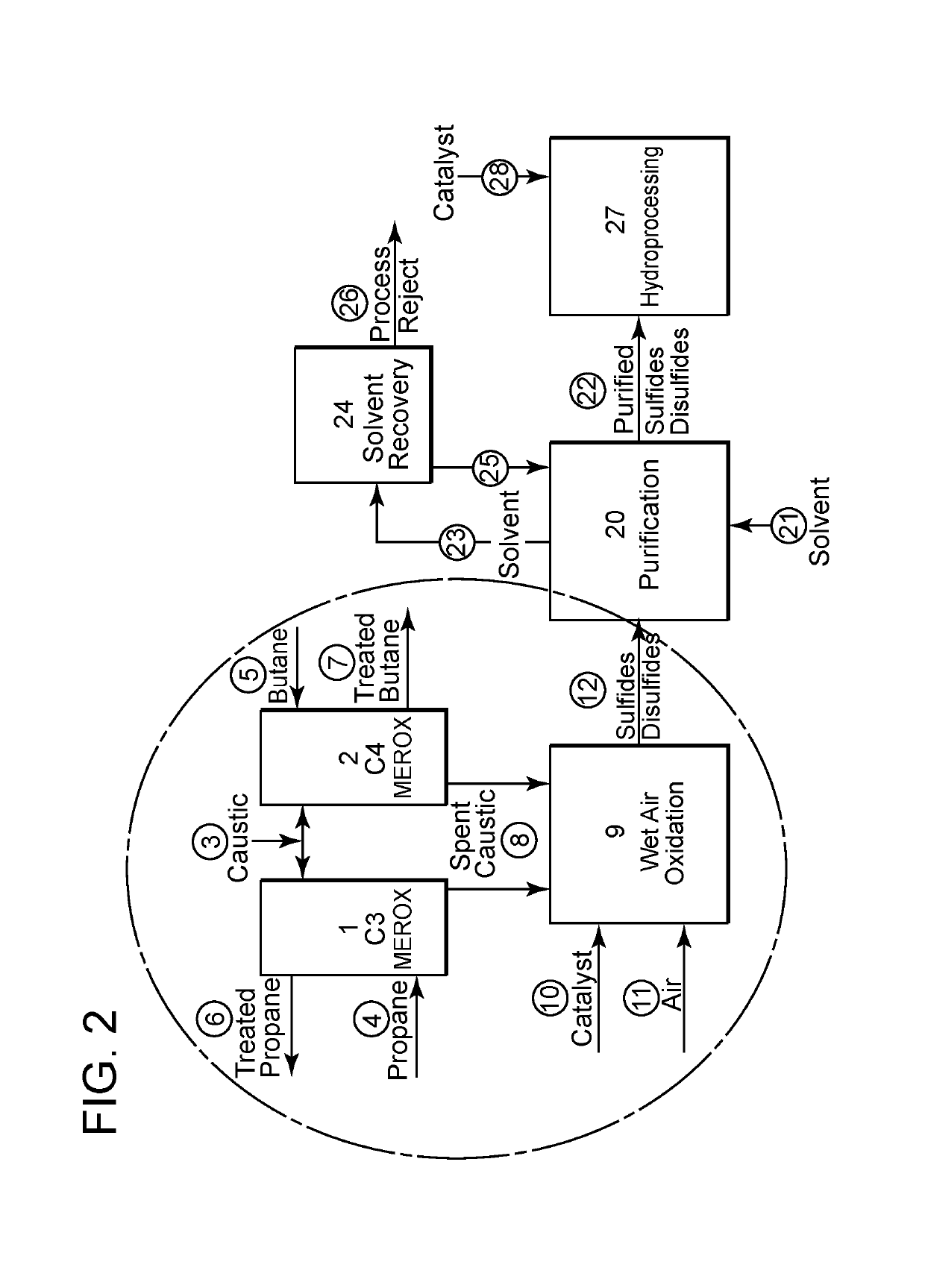Integrated process for activating hydroprocessing catalysts with in-situ produced sulfides and disulphides
a hydroprocessing catalyst and hydroprocessing catalyst technology, applied in the direction of physical/chemical process catalysts, separation processes, refining with aqueous alkaline solutions, etc., can solve the problems of difficult disposal of disulphide oil, disulphide oil is possible, and disulphide oil is not desirabl
- Summary
- Abstract
- Description
- Claims
- Application Information
AI Technical Summary
Benefits of technology
Problems solved by technology
Method used
Image
Examples
example 1
[0035]Two diesel hydrotreating pilot plant tests were conducted. The catalyst to be activated, in each test, was an Ni—Mo hydrocracking catalyst in oxide form. The mode of activating the catalyst was to contact it with either commercially available DMDS, or recovered. DSO, obtained via the integrated process of the invention.
[0036]Activating solutions were prepared using kerosene fractions containing 1% sulfur, to which DMDS was added, to obtain 2% sulfur content.
[0037]To activate the catalyst, the reaction vessel was pressurized to 45 bars, using hydrogen followed by a 30 minute purge. The hydrogen flow was 27.5 NL / h and the temperature was increased to 175° C., in 25° C. / hr increments.
[0038]Commercially available activating solution (DMDS), was added at LHSV of 3 h−1, and held for 3 hours. The temperature was increased to 250° C. at the same rate as above. The concentration of H2S in the vessel was monitored every 30 minutes, until the level in the off gas exceeded 0.2 V %. Cataly...
example 2
[0040]This example compares commercially available DMDS sulfiding to DSO obtained using the invention. The DSO was obtained by combining the DSOs from propane and butane MEROX units, as described supra.
[0041]Activating solutions were prepared using kerosene fractions containing 1% sulfur, to which DSO was added, to obtain 2% sulfur content.
[0042]The vessel was pressurized to 45 bars, with hydrogen gas, and purged for 30 minutes. The rate of hydrogen flow was set at 27.5 NL / h, and the reactor temperature was increased to 175° C., at a rate of 25° C. / hour.
[0043]The catalyst activating solution was fed to the vessel, at a LHSV of 3 h−1, and held for 3 hours. The reactor temperature was then increased to 250° C., at a rate of 25° C. / hour. The H2S gas concentration was monitored every 30 minutes for sulfur breakthroughs, until the H2S concentration was greater than 0.2 V % in off gas. The vessel was held with the same gas and liquid flow rates for 8 hours, to complete activation.
[0044]FI...
example 3
[0045]The activated catalysts of Examples 1 and 2 were tested, using an SR gas oil, derived from a mix of Arabian light and heavy crude (25:75). Properties of the feedstock are in the following Table;
[0046]
TABLE 4Feedstock properties andcomposition.PropertyUnitValueSulfurW %1.45Densityg / cc0.8448Nitrogenppmw980° C.1135° C.17210° C.19820° C.23330° C.25440° C.27350° C.29360° C.31170° C.33080° C.35290° C.37995° C.400100° C.437
[0047]The feedstock was tested at constant pressure of 46 bars, LHSV of 0.95 h−1, and temperatures in the range 320° C.-400° C.
[0048]These conditions follow:
[0049]
TABLE 5Operating conditions of hydrotreating tests.VariableUnitTest 1Test 2Catalyst activating DMDSDSOAgentHydrogen partial Bar4646pressureLHSVh−10.950.95Temperature°C.300, 310, 320, 330, 340, 300, 320 and 340350, 360, 380 and 400Durationdays3 at each temperatures3 at 300 and 2 days at 320 and 340
[0050]The results are presented in FIG. 5. As seen both commercial DMDS and extracted DSO were effective in ac...
PUM
| Property | Measurement | Unit |
|---|---|---|
| Temperature | aaaaa | aaaaa |
| Temperature | aaaaa | aaaaa |
| Temperature | aaaaa | aaaaa |
Abstract
Description
Claims
Application Information
 Login to View More
Login to View More - Generate Ideas
- Intellectual Property
- Life Sciences
- Materials
- Tech Scout
- Unparalleled Data Quality
- Higher Quality Content
- 60% Fewer Hallucinations
Browse by: Latest US Patents, China's latest patents, Technical Efficacy Thesaurus, Application Domain, Technology Topic, Popular Technical Reports.
© 2025 PatSnap. All rights reserved.Legal|Privacy policy|Modern Slavery Act Transparency Statement|Sitemap|About US| Contact US: help@patsnap.com



